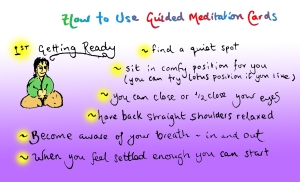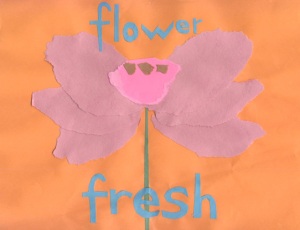Time
This activity can take 1 or 2 days, depending on the ages and interests of the children and how much time you have. Note: What you might say is in boldface. The answers to questions in parenthesis are the answers our children gave us.
Materials
Peanut butter
Dried Oatmeal
Honey
Sunflower seeds
…And any or all of these:
- Cinnamon
- Raisins
- Dried cherries
- Pumpkin seeds
- Chocolate chips
- Coconut flakes
- Dried date pieces
- Chopped almonds
Big bowl
Cookie sheets and/or trays
Napkin for each person being served
Refrigerator (optional)
Wash your hands.
Our teacher, Thich Nhat Hanh, has taught us two little poems to say when we wash our hands.
If children can read, one might read the gatha, as the other turns on the water and washes her hands. If children cannot read, the guide can read the gatha while the children wash their hands.
Turning on the Water
Water flows from high in the mountains.
Water runs deep in the Earth.
Miraculously, water comes to us,
And sustains all life.
Washing your Hands
Water flows over these hands.
May I use them skillfully
to preserve our precious planet.
Prepare the peanut butter balls
Combine all ingredients –the amounts are determined by the number of balls you want to make, how much of the various ingredients you have and how much you like each of the ingredients. Add the dry oatmeal to thicken, the honey to make it thinner.
Taste to see if they’re delicious. Add more ingredients if you like.
When the dough is just right, pinch off a piece and roll it between your hands until it forms a ball about the size of a jack’s ball. Children might like to invent a gatha for doing this! (Wet hands keep the dough from sticking.)
Place each ball on a cookie sheet.
When all of the dough has been formed into balls, put the cookie sheet in the refrigerator to chill until it is time to serve the Grown-Up Sangha. The snacks can sit for a week in the refrigerator if covered.
Discussion
Can you see a cloud in our peanut butter balls? Can you see a big truck? Can you see a lot of different people in our peanut butter balls?
If you look deeply, you can see all of these things…. and everything else as well! Let me help you look. What is peanut butter made of?
(peanuts)
Where do peanuts come from?
(plants)
What do peanut plants need to grow?
(air, water, soil, light.)
Where does the peanut plant get the water it needs to grow?
(rain)
Where does rain come from?
(clouds)
Aha! So that means there are clouds in our peanut butter balls, right? We could not have peanut butter balls if we did not have clouds, could we?
I said that I can also see a big truck in our peanut butter balls. Do you see it, now, too?
Can you explain how it got there?
(Accept all responses that show interbeing, e.g., “Trucks have to bring the nuts from the farm to the grocery store”.)
What else do you see in our peanut butter balls?
(This should be a very lively discussion! There is, of course, nothing that is not in the peanut butter balls, so all answers are “right”! Our children said, “I see Brazil because the cocoa that our chocolate chips are made from comes from there.” “I see the sunshine because sunflowers need sun.” “I see the people who picked the peanuts.” Continue the discussion until someone realizes that every one and every thing is in every one and every thing; that the all is in the one.)
We saw a cloud and a big truck and people and a lot of other things in our peanut butter balls. Can we see ourselves in our peanut butter balls?
(Invite children to explain. “I’m in the peanut butter balls because I made them.” “I’m in the peanut butter balls because I’m in the sun and the sun is in them!”)
Can we also see the cloud and big truck and other people in ourselves? Why? (“Yes, because they are in the peanut butter balls, and I am in the peanut butter balls; we are all in each other!” “I looked up at a cloud, so it is in me.” “I saw a truck once!”)
Why is it important to know that every one and every thing is a part of everything else? Why do we need to be able to see the cloud and big truck and all people and all those other things, including ourselves, in our peanut butter balls and in each other?
(“So that we will remember to take care of all things.” “So we don’t feel lonely.” “So we will love all people.”)
NOTE: You may want to complete this activity the next time you meet with the children. If so, cover and store the peanut butter balls in the refrigerator until you meet again. (They’ll be less sticky when they’re chilled.) You might want to review the previous discussion– using different examples– as a way of introducing the second day’s activity.
After the discussion, the children might like to practice serving each other before offering the snacks to the adult sangha. They will need to know how and why to bow [see Bowing activity]. A suggested way of serving follows.
Serve the peanut butter balls.
To serve the snacks, either place the peanut butter balls on pretty trays, or use the cookie sheets. Here is how we served our Adult Sangha. You might have other ways:
“Our Grown-Up Sangha is sitting in a big circle. There are places for us to sit, too. We enter the circle with our trays of peanut butter balls and napkins. We each go to a grown-up and kneel, placing our tray on the floor before him. We smile, put our hands together in the form of a flower and bow to the grown-up. The grown-up returns our bow then gets a napkin, chooses a snack and puts it on her napkin. We smile and bow to each other again. Then we stand and go to another grown-up until all the grown-ups have been served. We put a snack on a napkin in front of the places where we kids will sit, too. Then we join the grown-ups sitting in the circle. The Bell Master invites the bell and we all enjoy our snacks together.”
Submitted by Terry Cortes-Vega
Filed under: Activities you can try, Eating Meditation | Tagged: bowing, clouds, interbeing, peanut butter, peanuts, plants, rain, soil, truck, water | Leave a comment »





You must be logged in to post a comment.